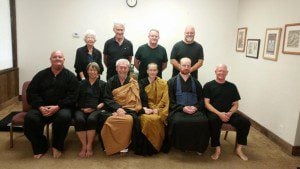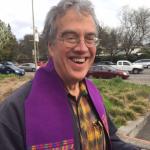A pause to catch my breath.
And in writing down some words to help focus what is going on.
So, here, just a brief description.
I am deeply committed to the transmission of the Zen Buddhist dharma to our Western shores. I have devoted a great deal of my life to the project of “liberal religion,” that is the rational spirituality and the calls out of that to the work of justice within Unitarian Universalism. That acknowledged, the heart drive, the “point” if you will of all this has always been about fostering the Zen way here on our beautiful Turtle Island.
The heart of the matter is a way of seeing, of living into this world. It is rooted in what Zen has identified as our astonishing ability to see the complexities of cause and effect where each of us rises and falls a moment in some great play, where we are unique and passing and deeply connected to everything. For me if there is a single sacred text it would have to be the Heart Sutra.
I am by disposition a naturalist. That is I see no need to add in any extras to the world that presents. From one angle this may look like materialism, but I strongly resist that. I don’t encounter this life of ours in any reductionist way, but rather as an unfolding mystery. And it is a place where the languages of religion seem most appropriate. So, naturalistic, but also spiritual.
And of the many spiritual paths available the one that has been most important, most formative has been Zen. Informed by the sentiments and style of liberal religion, but Zen.
Over the past fifty years I’ve walked two different aspects of the Zen way, and today I find myself trying to pull them together. Or, maybe its better said, they’re pulling themselves together and dragging me along for the ride.
I started practicing with the Berkeley Zendo, the East Bay extension of the San Francisco Zen Center led by the remarkable Japanese missionary Shunryu Suzuki. With them I began a regular Zen sitting practice. When the English Soto priest Peggy Teresa Nancy Kennett, better known as Houn Jiyu Kennett Roshi arrived in the Bay Area and began her Zen Mission Society I joined her. She ordained me a priest and within the permutations of her organization, while moving from a flat on Potrero Hill in San Francisco, to a large house in Oakland, to the acquisition of property near Mount Shasta, I threw myself fully into the Soto Zen way.
It was a quasi-monastic system, where I lived under rule in community, although I was permitted to marry. Actually, I was required to marry. (A long story. For another time.) It was very monastic. I lived through the rhythms called ango, formal training periods punctuated by regular sesshin. For me this was a brief time, lasting only a couple of years, but very intense. When I left I’d been ordained a full Soto Zen priest.
At the heart of that I was given dharma transmission. In the stories I’d been given this was a mystical gift connecting me with the ancestors of Zen and extending in some literal sense all the way back to the Buddha. While I genuinely had experiences which would be the foundation of my inner life, I was also wounded by the capricious and cult like experience with Kennett Roshi. So, dharma transmission has always been a conundrum for me, a gift, and a curse. And, I really didn’t know what to make of the whole thing, except to be clear I was glad to be away from the roshi and what would become the kaleidoscopic institution ever more tightly wound around her personal spiritual odyssey.
After that there was a period of wandering where I explored several alternatives, ranging from the Episcopal church, to ecclesiastical gnosticism, to the universalist Sufism taught by Inayat Khan and Samuel Lewis. There would be two brief marriages, and the beginnings of what has become a life long commitment, now rating well past thirty years.
And then I found what would be the course of my spiritual life for the next thirty years. At almost the same time I began attending Unitarian Universalist churches and practicing Zen with the lay koan master Dr John Tarrant. John has his own issues, but he was a perfect guide for me for many years, particularly as modified by my returning to school, earning an undergraduate degree and advanced degrees and then spending twenty-five years as a UU parish minister. With John I traced through the koan curriculum developed by Hakuin Ekaku and his circle in the Eighteenth century and then modified as a Soto reformed koan curriculum by Harada Daiun Sogaku in the early part of the twentieth century. And at the end of that project I was given another authorization. This one felt less ambiguous, although I was also more clearly aware of what it meant and what it did not mean.
When my partner Jan and I settled in New England, we found collaborators and Boundless Way, a wonderful Zen community emerged.
All of this gave me a life. And I remain eternally grateful to all my teachers and companions both ancient and modern.
But, now, as I retire from parish ministry, as I turn sixty-nine, as Jan & I settle into our lives in Long Beach, California, I find all of this focusing on what is likely to be my last project. So, the status report in the moment.
I keep a hand in with the Unitarian Universalist world. But, my major focus has been the cultivation of a Zen community. We started with a sitting group (Zen jargon for a Zen meditation group) at the Unitarian Universalist Church of Long Beach. Then we started a second sitting group meeting at the Orange Coast Unitarian Universalist Church in Costa Mesa. We also attracted an affiliated group in Washington State. While we continue in relationship with Boundless Way, I can see this new incarnation is taking on somewhat different shades.
What I feel is emerging here is a clearer blending of my two formative experiences. For me the koan way remains the heart of my spiritual discipline. And awakening is at the heart of the heart. But, I find I’m also pulled to the experiences that originally formed me. So, the disciplines of Soto and particularly the ordained path are becoming more and more important to me. I feel enormously lucky that Gesshin Greenwood, Sensei, is an early collaborator for this new group, trained almost exclusively in Japanese Soto Zen. I also feel fortunate in the more informal, but deeping friendship with Gyokei Yokoyama, Sensei, a Japanese Soto priest serving a Buddhist church in Long Beach. Each of these people pushing me and encouraging our community in ever richer ways.
I’m seeing a few new steps being introduced into my Zen dance. Our Zen dance.
We’ve had two one day sittings and another scheduled and have put a deposit down on a venue up on Mount Baldy for a three-day sesshin at the beginning of February.
This coming Saturday some very important things are happening. We start with a meeting of our forming leadership, the proto-board. Then we have a major marker, one of our seniors, someone who had received the precepts in the past, will renew his vows clearly within our community. And, then, we will have the first of our community pot luck.
Wonderful things are happening.
Endings and Beginnings.
All so compelling. And a little scary.














